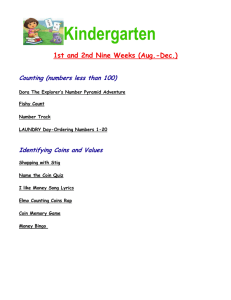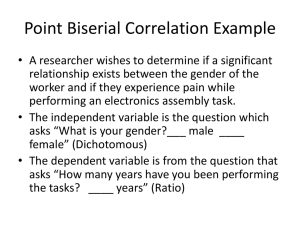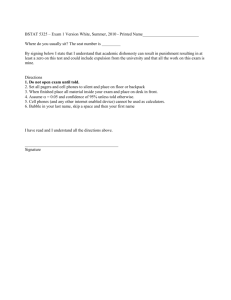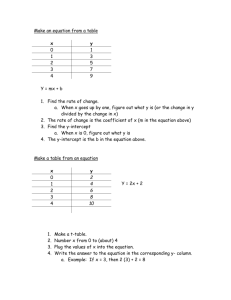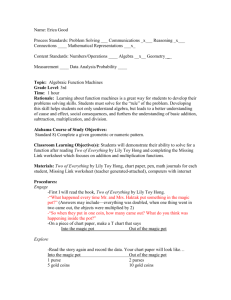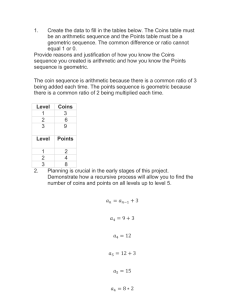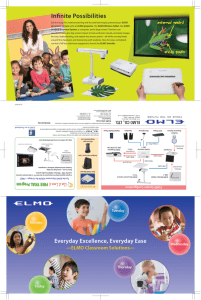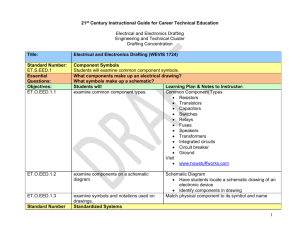Mathematics Lesson Design Template
advertisement
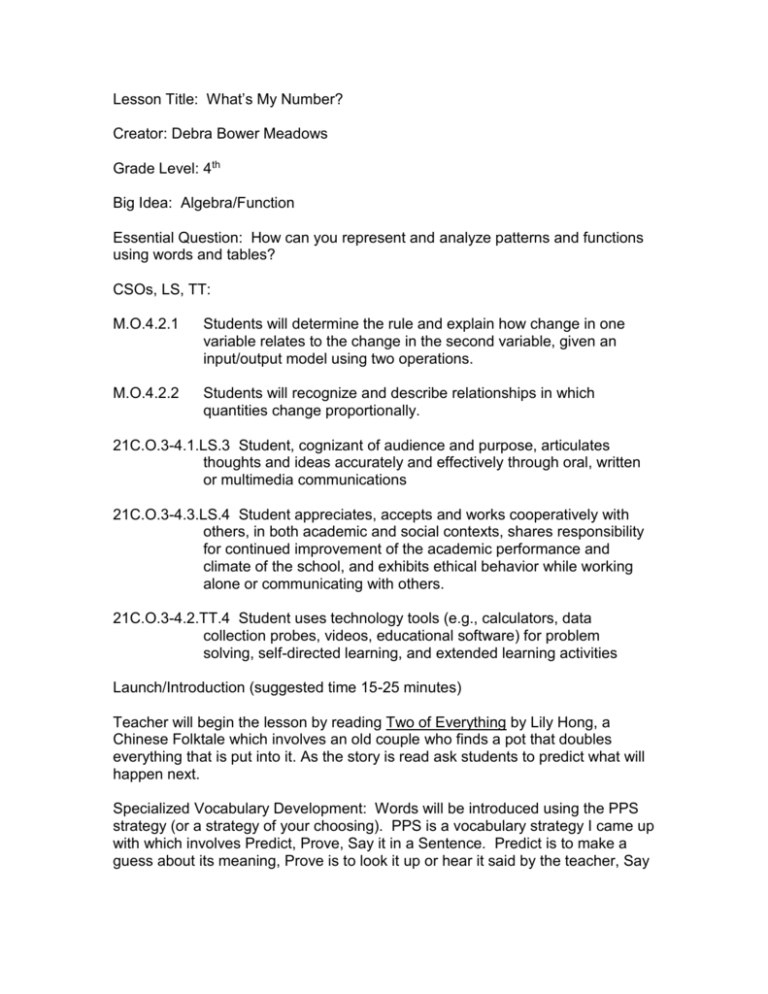
Lesson Title: What’s My Number? Creator: Debra Bower Meadows Grade Level: 4th Big Idea: Algebra/Function Essential Question: How can you represent and analyze patterns and functions using words and tables? CSOs, LS, TT: M.O.4.2.1 Students will determine the rule and explain how change in one variable relates to the change in the second variable, given an input/output model using two operations. M.O.4.2.2 Students will recognize and describe relationships in which quantities change proportionally. 21C.O.3-4.1.LS.3 Student, cognizant of audience and purpose, articulates thoughts and ideas accurately and effectively through oral, written or multimedia communications 21C.O.3-4.3.LS.4 Student appreciates, accepts and works cooperatively with others, in both academic and social contexts, shares responsibility for continued improvement of the academic performance and climate of the school, and exhibits ethical behavior while working alone or communicating with others. 21C.O.3-4.2.TT.4 Student uses technology tools (e.g., calculators, data collection probes, videos, educational software) for problem solving, self-directed learning, and extended learning activities Launch/Introduction (suggested time 15-25 minutes) Teacher will begin the lesson by reading Two of Everything by Lily Hong, a Chinese Folktale which involves an old couple who finds a pot that doubles everything that is put into it. As the story is read ask students to predict what will happen next. Specialized Vocabulary Development: Words will be introduced using the PPS strategy (or a strategy of your choosing). PPS is a vocabulary strategy I came up with which involves Predict, Prove, Say it in a Sentence. Predict is to make a guess about its meaning, Prove is to look it up or hear it said by the teacher, Say it in a sentence is just that, use the word in a sentence. Words to introduce include Input, Output, Function/Rule, t-table/t-chart, Input Output Machine. After the teacher has read the story students will relate the magic pot to a function machine and complete a t-table, (working along with the teacher as she projects one with either an Elmo or overhead). The students will continue a doubling pattern. The students will then describe and record their mathematical idea in words and numerically as they state the rule for the function machine. The lesson will then be expanded to include other operations and a variety of inputs. Students can role play being an input/output machine and other students can guess their rule. Have students explain their thinking aloud as they work through several different problems. Students can write in numbers and mathematical symbols as well as tell in a sentence what is happening to numbers that are placed into the function machine. Students will do a variety of problems sometimes finding the output, sometimes the input, and sometimes the rule that was used. As the lesson progresses include rules that involve 2 operations. (Like multiply by 2 then subtract 3) Some probing questions you might ask the students; How can you find the input if you know the output? Are there numbers that would not work in this machine? If the rule on a given T-chart were to continue what would be the 7th output or the 12th? Make sure they see the progression if numbers are skipped. Investigate/Explore: Students will work in pairs to answer the question: What would you rather have: 1000 coins or 5 coins and a Magic Doubling Pot that works 10 times? Circle your prediction on the worksheet and write down a brief reason for your prediction. Then work with your partner to decide which is the best choice and why. As students work on this using the given chart as a Ttable the teacher will confer with student groups and ask them to tell about their work and what they notice about how the numbers are growing. How many coins do you think will come out on the tenth time? Are you comfortable with your prediction or would you like to change it? Summarize/Debrief the Lesson (suggested time varies from 30-40 minutes) Bring the class back together and pose questions like: Did you make the right choice? How do you know? Review vocabulary and relate it to the story: What was the input? What was the output? What was the function machine? Did you use a t-table? What was the rule or function used in this story example? How can you represent a pattern? How do t-charts help? Optional: Smart Board Activity from Teacher Notes or computer activity Materials: The book Two of Everything, by Lily Hong, ISBN 0-8075-8157-7, Input and Output chart to complete, t-tables for recording their work. An Elmo or Overhead can be used to project teacher chart. Smart board if using the website listed given. Display chart could be used if Elmo or Overhead is not available. Duration: About 1 hour and 15 min. Teacher Notes: Here’s a song for the Conclusion: (Tune to Pop Goes the Weasel) All around the Function Machine, The numbers they were waiting. Put one in and follow the Rule Out comes the solution. Here are a couple of websites to practice function Machines on a Smart board http://www.amblesideprimary.com/ambleweb/mentalmaths/functionmachines.html http://teams.lacoe.edu/documentation/classrooms/amy/algebra/3-4/3-4.html T-Table for Doubling Input Output 0 0 1 2 2 4 3 6 4 8 14 9 10 15 36 38 50
